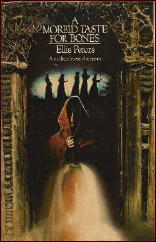Wed 3 Jul 2013

ELLIS PETERS – A Morbid Taste for Bones. Popular Library, reprint paperback, 1980. First Edition: Macmillan, UK, hardcover, 1977. First US Edition: Morrow, hardcover. 1978. Reprinted many times since, in both hardcover and soft.
Well, yes, I admit it, you’ve caught me. I’ve always claimed not to care for period detective fiction, be it Victorian, 12th century, pre-Elizabethan, or what. But I liked Brother Cadfael as a character in One Corpse Too Many, reviewed here not so very long ago, so much so that when I saw this earlier book was out in paperback, I picked it up and started reading it while I was still in the store, and I ended up not putting it down until well after I got home.
Some of Cadfael’s earlier, non-ecclesiastical career is revealed in Bones — he was a sailor and a Crusader, very much an adventurer and a man of the world. And yet, with all this life behind him, he has found it easier to adjust to life in the monastic enclave of Shrewsbury Abbey than have some of the younger men.
In fact, rather than arising from a civil disturbance of the sort that produced the murder mystery of One Corpse Too Many, the crisis of this earlier book focuses inwardly, upon the personalities and the not always totally spiritual ambitions of various of the brothers.
In particular, it is Prior Robert’s dream of removing the bones of Saint Winifred to England from her burial place in her home country of Wales that initiates the sequence of events that culminates, not unexpectedly, in murder.
Thwarted romance is also involved. In Cadfael’s objective eye toward such matters, God often needs a little helping hand from man. The culprit is easily spotted, thanks to better-than-average characterization — could this by why some people object so loudly to characterization in detective stories?
Are mysteries and good writing incompatible? I refuse to think so.
Occasionally the dialogue waxes exceedingly biblical in tone, and some tolerance for it has to be developed. And perhaps it shouldn’t have, but a reference to a steel-tipped arrow surprised me a little.
Rating: B.
Vol. 4, No. 4, July-August 1980 (somewhat revised).
[UPDATE] 07-03-13. No, it really shouldn’t have. From Wikipedia:
“The earliest known production of steel is a piece of ironware excavated from an archaeological site in Anatolia (Kaman-Kalehoyuk) and is about 4,000 years old. Other ancient steel comes from East Africa, dating back to 1400 BC. In the 4th century BC steel weapons like the Falcata were produced in the Iberian Peninsula, while Noric steel was used by the Roman military.”
Oops. I didn’t know that!